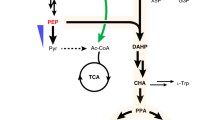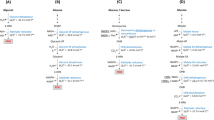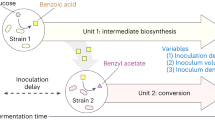Abstract
Glucose is the preferred substrate for certain fermentation processes. During its internalization and concomitant formation of glucose-6-phosphate through the glucose phosphotransferase system (PTS), one molecule of phosphoenolpyruvate (PEP) is consumed. Together with erythrose 4-phosphate (E4P), PEP is condensed to form 3-deoxy-D-arabino-heptulosonate 7-phosphate (DAMP), the first intermediate of the common segment of the aromatic pathway. From this metabolic route, several commercially important aromatic compounds can be obtained. We have selected Escherichia coli mutants that can transport glucose efficiently by a non-PTS uptake system. In theory, this process should increase the availability of PEP for other biosynthetic reactions. Using these mutants, in a background where the DAMP synthase (the enzyme that catalyzes the condensation of PEP and E4P into DAMP) was amplified, we were able to show that at least some of the PEP saved during glucose transport, can be redirected into the aromatic pathway. This increased carbon commitment to the aromatic pathway was enhanced still further upon amplification of the E. coli tktA gene that encodes for a transketolase involved in the biosynthesis of E4P.
This is a preview of subscription content, access via your institution
Access options
Subscribe to this journal
Receive 12 print issues and online access
$209.00 per year
only $17.42 per issue
Buy this article
- Purchase on Springer Link
- Instant access to full article PDF
Prices may be subject to local taxes which are calculated during checkout
Similar content being viewed by others
References
Frost, J. and Lievense, J. 1994. Prospects for biocatlytic synthesis of aromatics in the 21st century. New J. Chem. 18: 341–348.
Murdock, D., Ensley, B.D., Serdar, C. and Thalen, M. 1993. Construction of metabolic operons catalyzing the de novo biosynthesis of indigo in Escherichia coli . Bio/Technology 11: 381–085.
Patnaik, R. and Liao, J.C. 1994. Engineering of Escherichia colicentral metabolism for aromatic metabolite production with near theoretical yield. Appl. and Environ. Microbiol. 60: 3903–3098.
Patnaik, R., Spitzer, R.G. and Liao, J.C. 1995. Pathway engineering for production of aromatics in Escherichia coli: Confirmation of stoichiometric analysis by independent modulation of AroG, TktA and Pps activities. Biotech. Bioeng. 46: 361–370.
Postma, P.W. 1987. Phosphotransferase system for glucose and other sugars, pp. 127–141 in Escherichia coli and Salmonella typhimurium. Cellular and Molecular Bology.Neidhardt, EC. (ed.). American Society for Microbiology, Washington, D.C.
Mori, M., Yokota, A., Sugitomo, S. and Kawamura, K. 1987. Process for the isolation of a strain with reduced pyruvate kinase activity or completly lacking it. Patent JP 62,205,782.
Saier, M.H., Bromberg, F.G., and Roseman, S. 1973. Characterization of constitutive galactose permease mutants in Salmonella typhimurium . J. Bacteriol. 113: 512–514.
Biville, F., Turlin, E., and Gasser, F. 1991. Mutants of Escherichia coliproducing pyrroloquinoline quinone. J. Gen. Microbiol. 137: 1775–1782.
Fraenkel, D.G. 1987. Glycolisis, pentose phosphate pathway, and Entner-Doudoroff pathway, pp. 142–150 in Escherichia coli and Salmonella typhimurium. Cellular and Molecular Biology. Neidhardt, EC. (ed.). American Society for Microbiology, Washington, D.C.
Ponce, E., Flores, N., Martinez, A., Allen, F., and Bolivar, F. 1995. Cloning of the two pyruvate kinase isoenzyme structural genes from Escherichia coli: the relative roles of these enzymes in pyruvate biosynthesis. J. Bacteriol. 177: 5719–5722.
Frost, J.W. 1992. Enhanced production of common aromatic pathway compounds. Patent US 5,168,056.
Holms, W. 1986. The central metabolic pathways of Escherichia coli: relationships between flux and control at a branch point, efficiency of conversion to biomass, and excretion of acetate, pp. 69–105 in Current Topics in Cellular Regulation. Horecker, B.L. and Stadtman, E.R. (eds.). Academic Press, New York.
Yanisch-Perron, C., Vieira, J. and Messing, J. 1985. Improved M13 phage cloning vectors and host strains: nucleotide sequence of the M13mp18 and pUC19. Gene 33: 103–119.
Mascarenhas, D. 1987. Tryptophan producing microorganisms. Patent WO 87/01130.
Levy, S., Zeng, G.Q. and Danchin, A. . 1990. cAMP synthesis in strains bearing well characterized deletions in the central pts genes of Escherichia coli . Gene 86: 27–33.
Draths, K.M., Pompliano, D.L., Conley, D.L., Frost, J.W., Berry, A., Disbrow, G.L., Staversky, R.J. and Lievense, J.C. 1992. Biocatalytic synthesis of aromatics from D-glucose: the role of transketolase. J. Am. Chem. Soc. 114: 3956–3962.
Silhavy, T., Berman, M. and Enquist, L. 1984. pp. 110–112 in Experiments with Gene Fusions. Cold Spring Harbor Laboratory Press, New York.
Cordaro, J.C., Melton, T., Stratis, J.R., Atagun, M., Gladding, C., Hartman, P.E., and Roseman, S. 1976. Fosfomycin resistance: selection method for internal and extended deletions of the phosphoenolpyruvate: sugar phosphotransferase genes of Salmonella typhimurium . J. Bacteriol. 128: 785–793.
Maniatis, T., Fritsch, E.F. and Sambrook, J. 1989. Molecular Cloning. A Laboratory Manual. Cold Spring Harbor Laboratory Press, New York.
Ramseier, T.M., Bledig, S., Michotey, V., Feghali, R., and Saier, M.H., Jr. 1995. The global regulatory protein FruR modulates the direction of carbon flow in Escherichia coli . Mol. Microbiol. 16: 1157–1169.
Bochner, B.R. and Savageau, M.A. 1977. Generalized indicator plates for genetic, metabolic, and taxonomic studies with microorganisms. Appl. Environ. Microbiol. 33: 434–444.
Srinivasan, P.R. and Sprinson, d.B. 1959. 2-keto-3-deoxy-D-arabo-heptonic acid 7 phosphate synthase. J. Biol. Chem. 234: 716–722.
Author information
Authors and Affiliations
Rights and permissions
About this article
Cite this article
Floras, N., Xiao, J., Berry, A. et al. Pathway engineering for the production of aromatic compounds in Escherichia coli. Nat Biotechnol 14, 620–623 (1996). https://doi.org/10.1038/nbt0596-620
Received:
Accepted:
Issue Date:
DOI: https://doi.org/10.1038/nbt0596-620
This article is cited by
-
Construction of Synthetic Microbial Consortium for Violacein Production
Biotechnology and Bioprocess Engineering (2023)
-
Advances and prospects in metabolic engineering of Escherichia coli for L-tryptophan production
World Journal of Microbiology and Biotechnology (2022)
-
Construction of recombinant Escherichia coli for production of l-phenylalanine-derived compounds
World Journal of Microbiology and Biotechnology (2021)
-
Evolution of an Escherichia coli PTS− strain: a study of reproducibility and dynamics of an adaptive evolutive process
Applied Microbiology and Biotechnology (2020)
-
Metabolic engineering of Escherichia coli for production of chemicals derived from the shikimate pathway
Journal of Industrial Microbiology and Biotechnology (2020)



